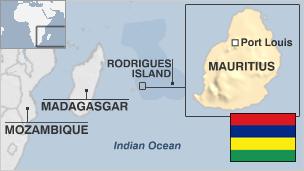

-
16 June 2015
- From the section Africa

Mauritius, a volcanic island of lagoons and palm-fringed beaches in the Indian Ocean, has a reputation for stability and racial harmony among its mixed population of Asians, Europeans and Africans.
The island has maintained one of the developing world’s most successful democracies and has enjoyed years of constitutional order.
It has preserved its image as one of Africa’s few social and economic success stories.
Once reliant on sugar as its main crop export, Mauritius was hit by the removal of European trade preferences but has successfully diversified into textiles, upmarket tourism, banking and business outsourcing.
The strategy helped the island’s economy weather the world financial crisis of 2008-9 better than expected.
Various cultures and traditions flourish in peace, though Mauritian Creoles, descendants of African slaves who make up a third of the population, live in poverty and complain of discrimination.
Mauritius was uninhabited when the Dutch took possession in 1598. Abandoned in 1710, it was taken over by the French in 1715 and seized by the British in 1810.
It gained independence in 1968 as a constitutional monarchy, with executive power nominally vested in the British monarch. It became a republic in 1992.
The island of Rodrigues and other smaller islets also form part of the country.
Mauritius claims sovereignty over the Chagos islands, which lie around 1,000 km to the north-east. The British territory, which was separated from Mauritius in 1965, is home to the US military base on Diego Garcia. The British government oversaw the forced removal of the Chagos islanders to Mauritius to make way for the base.
The country is home to some of the world’s rarest plants and animals. But human habitation and the introduction of non-native species have threatened its indigenous flora and fauna.
The dodo – a flightless bird and a national symbol – was hunted into extinction in the 17th century.



